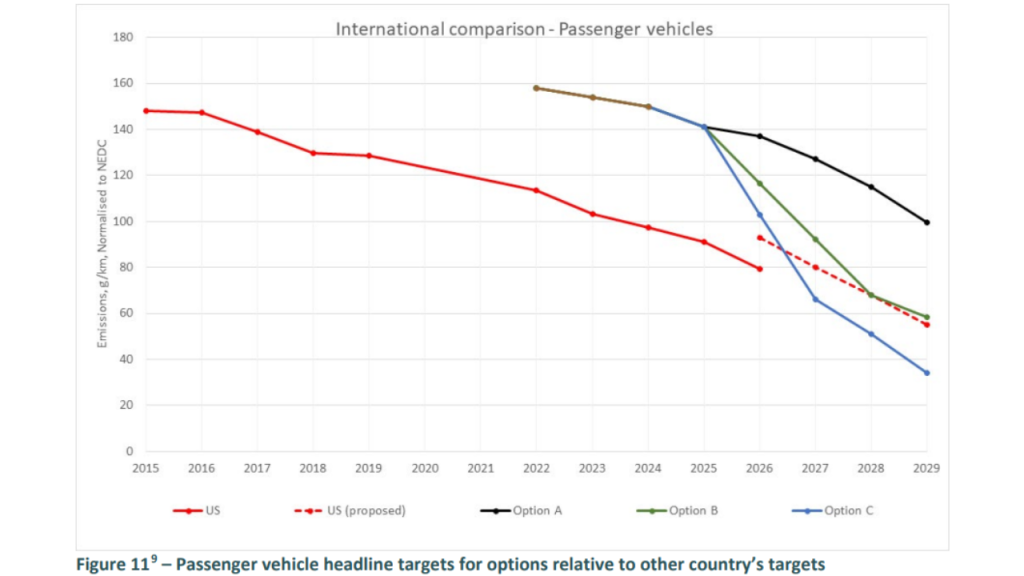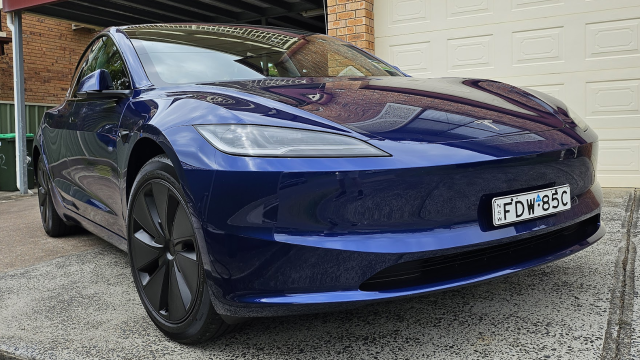Over the weekend, after a long consultation period the Australian Government finally announced its plan for fuel efficiency standards.
If you’re out of the loop, such standards would require automakers to meet an efficiency level for all new cars sold in Australia.
As in, meeting the emissions level or lower of emitted Carbon dioxide, or CO2, over a kilometre of driving.
Every OECD country in the world has them, except Australia and, until 2022, Russia (Russia was suspended from the OECD for invading Ukraine, and still doesn’t have fuel standards).
The proposed rules would apply averaged standards across the fleets of cars sold by manufacturers within Australia – with the CO2 threshold still to be applied (for example, Europe enforces standards of 120.4gCO2/km, while the U.S. enforces 129.9gCO2/km). Proposed thresholds can be viewed on page 32 of the Impact Analysis.
Three models to choose from
These standards would only apply to new cars and are set to start from 2025 when the government hopes they’ll be legislated. The government is currently consulting on the preferred model, looking at three options with stakeholders, which it will do for a month.
The standards would become more stringent as time goes on, with manufacturers and dealers required to sell more efficient vehicles later on.
According to the impact analysis, “Suppliers can still sell any vehicle they like, but will need to sell more clean cars to offset higher emission cars they sell. If suppliers sell more fuel-efficient cars than the target, they get credits. If they sell more polluting cars than the target, they need to buy credits from a different supplier or, eventually, pay a penalty.”

Of the three options, Option A seeks to provide the slowest, least effective start, and Option C seeks to enforce stronger standards than those in The States. For exceeding the set thresholds, suppliers could be fined up to $200 for every exceeding gram of carbon dioxide per km.
“We’re giving Australians more choice to spend less on petrol, by catching up with the U.S.– this will save Australian motorists $100bn in fuel costs to 2050,” the federal minister for climate change and energy Chris Bowen said.
What does any of this mean to me?
Let’s be clear: these new rules do not mean SUVs and utes are being banned. The main takeaway from this is that new Australian cars sold after 2025 will have more efficiency per kilometre while having a positive impact on the environment. With cars required to meet thresholds for emitting CO2, less petrol will be used in your day-to-day life, with the federal government projecting $1,000 in annual savings for drivers by 2028 because of this.
Among supporters of these standards, Australia has been considered a ‘dumping ground’ for less efficient vehicles, as in countries with such standards, cars are more efficient (who would have thought?). Cars in Australia use 20 per cent more fuel in Australia than the U.S., according to the Australian Government, or a third, according to the Australian Electric Vehicle Council. This means higher running costs, greater consumption, and a worse impact on the environment.
Does this mean I can finally buy an EV?
The government’s announcement is a victory for the Australian Electric Vehicle Council, which has long lobbied for fuel efficiency standards. They argue that, with automakers forced to make more efficient cars, they’ll be more inclined to sell electric models in Australia, which are undoubtedly much more efficient than combustion engine cars.
The federal government has today released it’s proposed New Vehicle Efficiency Standard.
— Behyad Jafari ⚡🚘 (@BJafari) February 3, 2024
Once legislated, these standards will result in greater choice and lower fuel bills for Australian motorists. Statement: pic.twitter.com/QbDE4Bkpno
But there’s been no talk of a mandate to force carmakers to sell electric cars – just more efficient ones – and that’s the tone the climate change and energy minister has gone with.
“This is about ensuring Australian families and businesses can choose the latest and most efficient cars and utes, whether they’re petrol and diesel engines, or hybrid, or electric,” Minister Bowen added.
There’s also nothing forcing carmakers to drop the prices of electric vehicles immediately, which has been one of the greatest barriers of entry for switching off cheaper-to-buy combustion engine cars. While that doesn’t mean the government doesn’t appreciate electric models, the tightening of efficiency thresholds over time will require automakers to start to supply much more efficient vehicles – so you can expect to see more models popping up.
“The IPCC (Intergovernmental Panel on Climate Change) and IEA (International Energy Agency) have both identified that EVs powered by renewable electricity as having the largest emissions reduction potential for land transport. This technology will be crucial for achieving Australian and global emissions reduction targets,” the paper reads.
Speaking broadly, more electric models will likely be sold in Australia because of these changes, whether they’ll come down in price quickly or not isn’t related to this plan, but will likely happen as the technology is improved and as the standards tighten over time.
“Most important is that Australian families and businesses can continue to access the style of vehicle that suits their needs for work and recreation,” the Federal Chamber of Automotive Industries chief executive Tony Weber said.
Is anybody worse off?
Apart from automakers no longer being able to sell cars in Australia that are largely more inefficient than those in the rest of the world, there aren’t many losers from introducing such laws. The Australian Automotive Dealer Association (AADA), however, believes that the federal government is moving too far and too fast with these rules.
“On the surface, this is an incredibly ambitious target which will be difficult to achieve especially for utes and large SUVs,” said AADA CEO James Voortman. “This could have consequences for affordability and vehicle choice.”
Under the proposed rules, suppliers would still be able to sell less efficient vehicles, however, they’d either need to take advantage of the proposed credits system, or make up for less efficient vehicles by selling other more efficient models. The idea that consumers would need to bear the costs of more efficient vehicles doesn’t hold up when we look at other markets with greater choice and fuel efficiency standards.
Meanwhile, renewable energy and transport organisation Solar Citizens has tied the introduction of standards to lower bills altogether, noting that more people will be encouraged to go electric with more options available.
“Electric vehicle sales hit record numbers last year and more Australians want to get behind the wheel of cheaper to run, more fuel-efficient vehicles – but cost remains a barrier,” Solar Citizens CEO Heidi Lee Douglas said.
“This new standard will provide more choices of both electric and more efficient fuel-efficient vehicle models, including more affordable electric vehicle options.”
It’s expected that fuel efficiency standards will be introduced by January 1, 2025, though there will likely be much deliberation between now and then.
Image: Zachariah Kelly/Gizmodo Australia
Want more Aussie car news? Here’s every EV we’ve reviewed in the last two years, all the EVs we can expect down under soon, and our guide to finding EV chargers across the country. Check out our dedicated Cars tab for more.
